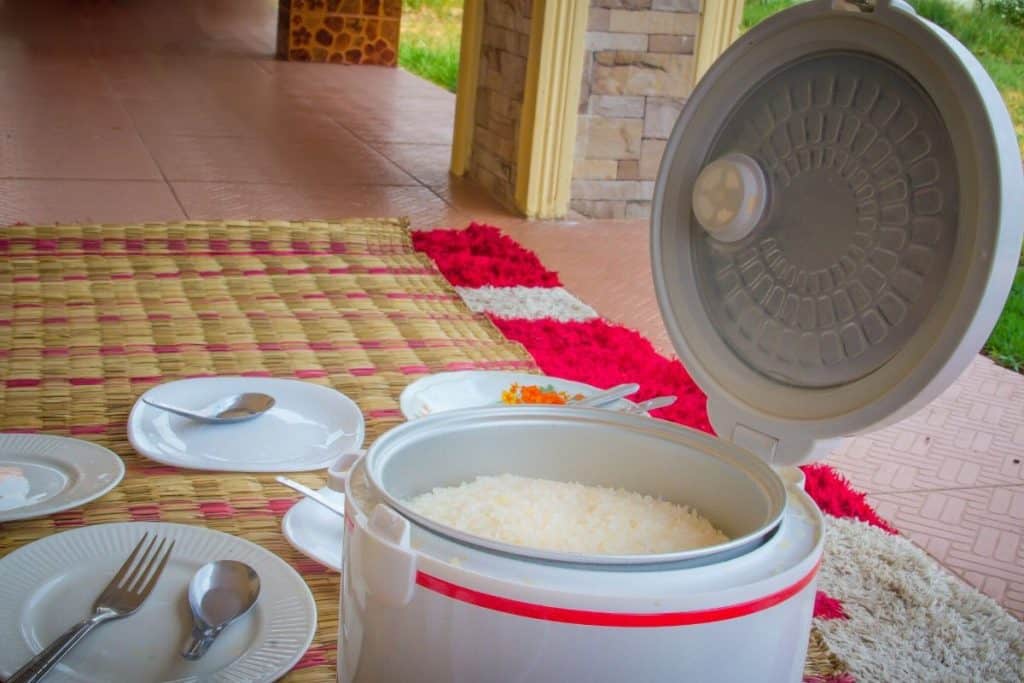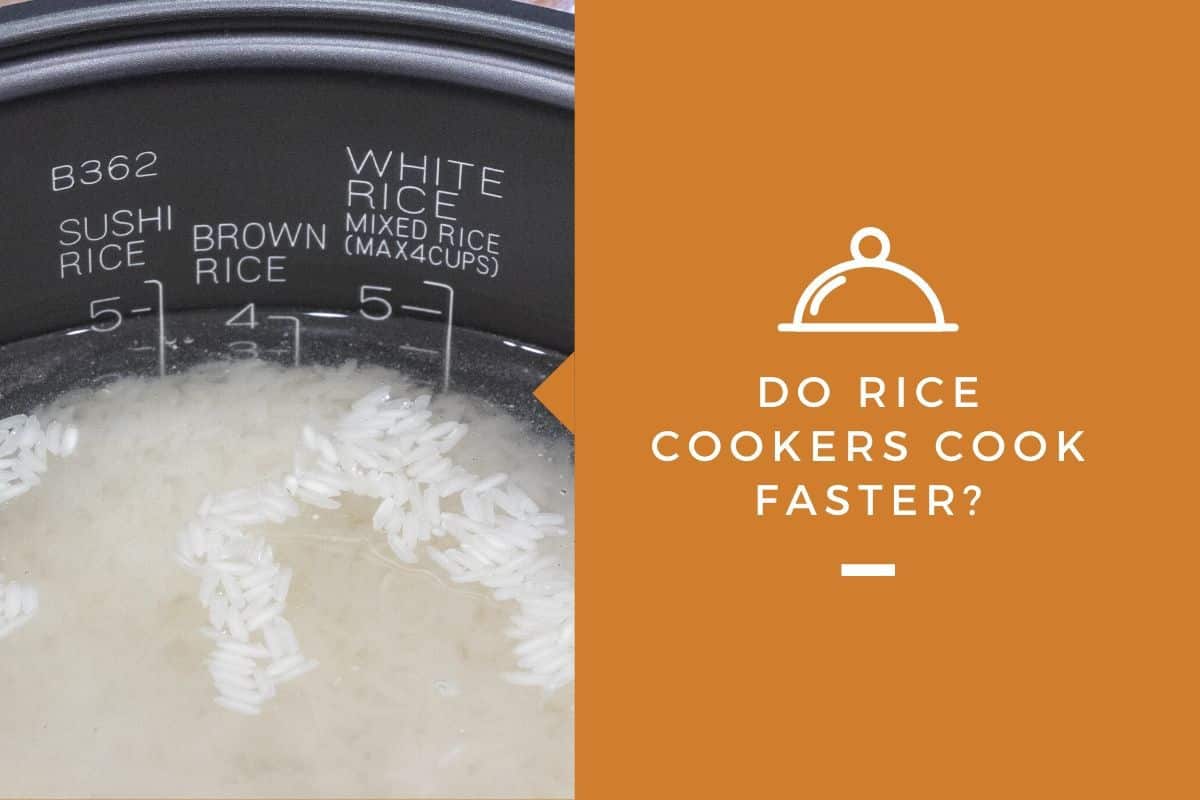Rice is the dietary staple of 3.5 billion people who depend on it for 20% of their daily calories. So, it’s no wonder that there are so many ways to prepare it. Whether you’re making risotto or homemade sushi, you’re probably wondering if there’s one particular way that cooks it the fastest.
Do rice cookers cook faster? There are so many types of rice, but there are also various methods of cooking it. Depending on what you’re making, the fastest way to cook your rice may change. A rice cooker is great, but here are a couple of other ways to cook it.
| Cooking Method | Type of Rice | Time To Cook |
| Simmer and Steam | Minute Rice | 10 to 12 minutes |
| Simmer and Steam | Standard, white | 18 to 20 minutes |
| Boiled Like Pasta | Wild Rice | 45 to 60 minutes |
| Pilaf Method | Jasmine or Basmati | 28 to 30 minutes |
| Rice Cooker | Standard, white | 15 minutes |
| Rice Cooker | Parboiled, white | 20 minutes |
| Rice Cooker | Standard, brown & wild | 40 to 45 minutes |
| Instant Pot | Standard, white | 5 minutes* |
| Instant Pot | Standard, brown | 10 minutes* |
| Instant Pot | Wild | 15 minutes* |
*The Instant Pot requires an additional 10 minutes to naturally release the pressure for fluffy texture, or you can release the pressure manually (although this affects the texture).
So, whether you’re looking for a quick dish or anticipating the joy of cooking, there’s a method for you. Using the table above as a reference, you can make rice just the way you like it.
But, if you’re really interested in what some of these methods entail or if you want to know why it works like this, keep reading. We’re going to take a deep dive into everything, including the rice cooker.
The Ever-Important Rice to Water Ratio
The key to perfect rice is hydration. And every grain type requires a different level of moisture to achieve that toothsome bite. Most rice is a 1 to 2 ratio.
That means that for every 1 cup of dry rice, you need 2 cups of water to cook it. However, there are several variations, and after some research, we’ve found that the best rice per type requires different hydration levels.
Here’s a table for future reference:
| Type of Rice | Rice To Water Ratio (r:w) |
| Standard, white rice | 1:2 |
| Long grain brown rice | 1:1 1/4 |
| Short grain brown rice | 1:1 1/2 |
| Wild rice | 1:3 |
| Sushi rice | 1:1 |
| Aborio rice | 1:3 (using broth instead of water) |
| Basmati rice | 1:1 3/4 |
| Jasmine rice | 1:2 |
| Black rice | 1:2 |
What Texture Rice Do You Need?
As important as it is to choose the right cooking method for the rice dish you desire, it’s equally, if not more, important to know how much liquid your rice needs to absorb to achieve the expected texture. For instance:
- A dish where the rice needs integrity, like sushi, requires a lower hydration ratio of 1 cup of rice to 1 cup of water. That does not include the addition of rice vinegar that will add its signature stickiness.
- However, a classic risotto will take up to 3 cups of liquid in the form of hot broth and wine to reach the creamy consistency that connoisseurs look forward to.
Why Do Whole Grains Take Longer to Cook?

You’ll notice that not only do whole grain rice varieties, especially wild rice, require longer cooking but also more water. What’s going on there? Once you understand the physiology of a rice grain, it’ll make sense.
White rice is created by scrubbing off the bran of the natural grain. The bran is the outer shell that gives color to brown, black, and wild rice. Without this, moisture absorbs more readily into the rice. That’s why it takes less water and time to cook a white variety.
So, then, the bran coating is what requires more effort to hydrate and cook. This is because the bran contains the natural oils of the grain. As you know, oil and water don’t mix.
So, it takes more time and water to work through the oily bran layer and to soften it to a palatable texture. But it sure is worth it.
Rice Cooker vs. Instant Pot
When the Instant Pot first hit the market, everyone was talking about how it was just an overhyped rice cooker. But then we all tried it and realized there were, in fact, a good many differences between the two.
Rice Cookers are Pretty Great
A rice cooker is truly dedicated to its function. It has settings that take the guesswork out of how long to cook each type of rice. If you’re cooking white rice, you will set it to “White Rice.” Brown rice? There’s a “Brown Rice” setting.
A rice cooker is just about foolproof, as long as you follow the instructions for the water to rice ratio.
The other benefit is that it generally cooks your rice to a perfect consistency in record time. Compared to the simmer and steam method, you can save 5 minutes on cooking white rice or nearly 15 minutes cooking wild rice.
Is the Instant Pot Actually Faster, Though?
The rice cooking times for the Instant Pot are pretty amazing. You can cook white rice in 5 minutes, brown rice in 10, and wild rice in 15 minutes. It’s just so astounding; it must be too good to be true. Well, honestly, it kind of is. Yes, it can cook rice at those quick times.
However, the times they list on their cheat sheet don’t list the sealing time or the depressurizing time. In general, sealing can take about 5 minutes before cooking even starts. Then, if you allow it to depressurize naturally, it will take another 10 minutes.
While there’s not much you can do about the sealing time, you can depressurize your Instant Pot manually. However, it may lead to gummy rice instead of the fluffy kind you want. So, it might be best to just let your Instant Pot do its thing.
That means it almost always takes less time to use a rice cooker than to make your rice in an Instant Pot. There is one exception. Wild rice will take about the same amount of time, or less, in the Instant Pot.
We Should Probably Mention the Microwave Method
Can you cook rice in the microwave? Yes, but should you? Probably not. So-called “Minute” rice cooked in the microwave requires 6 minutes of cooking time plus 5 minutes of steam time. At the end of this process, you’ll have rice that is perfectly okay, albeit it potentially gummy
However, it’s definitely not a feasible cooking methodology for any other grain variety. It’ll take ages, and you’ll probably end up with starchy water all over the bottom of your microwave from it boiling over, even if you cover it properly. You’re better off with a pot on the stove or a rice cooker.
Wrapping It Up…Like Sushi
Take a look at some of the links in the methodology table for different recipes on how to cook your rice. We’re especially thrilled with the results from the Martha Stewart recipe and the revolutionary baked rice from BWB (seriously, though, give the fried rice a shot. It’s incredible!).
However, for plain rice that goes with any number of dishes, consider a rice cooker for the quickest route to the table. If you’re an Instant Pot fan, though, know that this is a great alternative to a rice cooker.

